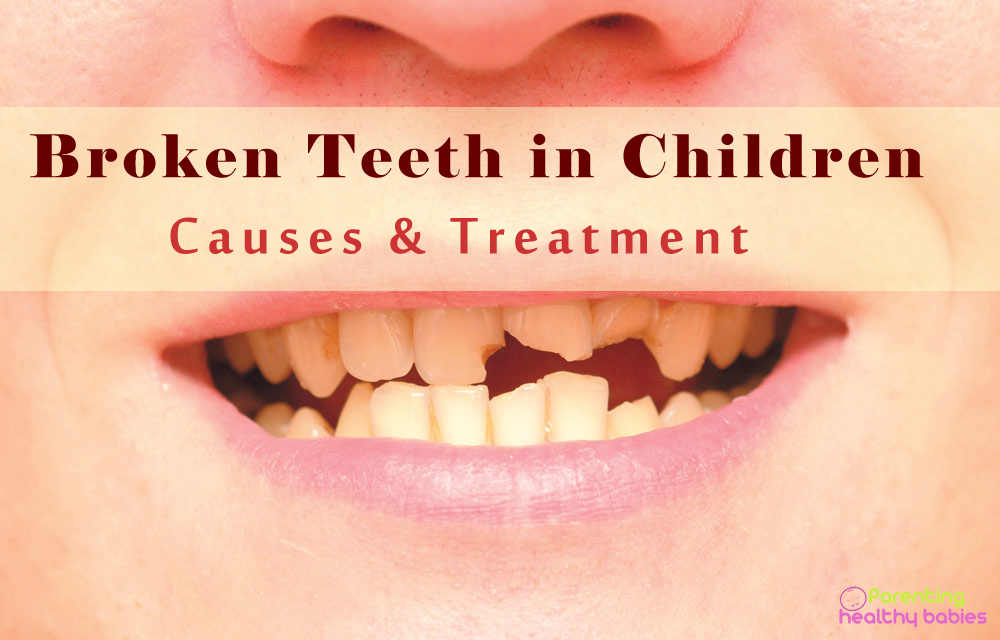A beautiful sparkly smile is one of the best assets of a child. However, children are accident prone and tend to incur injuries as they play. Generally, the upper front teeth of children or maxillary incisors tend to break due to trauma. The location of dental injury can be anywhere such as playgrounds, schools or at parks. A child’s baby teeth or permanent teeth may fracture, depending on the child’s age. Beyond 6 years, the upper front teeth begin to erupt and from then on a fracture of permanent teeth is more likely.
Signs and Symptoms of Broken Teeth
A broken tooth appears to be chipped off slightly or broken halfway across the tooth. The tooth fracture line may run horizontally or obliquely across the tooth. A child will complain of sensitivity to hot or cold liquids or tooth pain. The tooth may also appear discolored – a gray to brown-black discoloration may appear. The tooth may also show swelling of the gums or tissues around it. A child may also have difficulty eating or putting pressure on the tooth.
Causes of broken teeth
Children are, by nature, adventure seeking and love to play and explore. The down side of such activities is a tendency for dental injury. There are many reasons for broken teeth in children such as –
- Children about 1 year of age are just learning to walk. Their motor skills are not well developed. This leads to frequent falls or stumbling which can lead to a tooth chipping off or breaking.
- Sports related tooth injury can occur at any age. These can be due to being hit by objects such as sports balls flying at high speed or falls. Sports such as boxing, martial arts, skating, football, hockey or wrestling have higher rate of dental injuries.
- Some biologic factors may lead to more tooth injury in some children than others. Children with protruding upper teeth or increased overjet have more tendencies to injure their teeth. This type of dental injury prone jaw relationship is called Class II malocclusion.
- Unintentional falls from swings or climbing bars in the playground can lead to tooth fractures in children.
- Personality traits such as risk taking behavior or adventurous children tend to injure their teeth more than shy or less active children.
- Teenagers are inherently rash and thrill seeking in their nature. Teens may injure their teeth due to traffic or motor accidents such as motorbike accidents. Physical fights or violence with other teens may also be a cause of tooth injury in older children.
- Children with certain disabilities or conditions such as epilepsy, cerebral palsy or other neuro- motor conditions can be prone to dental injuries than other children.
- Child abuse or physical violence against children may also lead to dental trauma or broken teeth.
Management
The management of dental injury may be divided into 2 parts – prevention and treatment of broken teeth. Read on for information.
Tips to prevent broken teeth in children
-
Supervise your child
Broken teeth in children are frequently due to lack of supervision. It is important to ensure that your child plays under supervision of you, as parents or school teachers. Many broken teeth due to accidental falls and fights can be prevented by providing a controlled environment to children and intervening to prevent potential dental trauma before it occurs. Never leave your child to play or explore unsupervised.
-
Use safety gear during sports
Prevention of sports related dental injuries is possible through the use of safety gear. Mouthguards or mouth protectors help to prevent broken teeth in contact sports such as boxing and wrestling as well as soccer and football. These are injury prevention splints that fit over the teeth. They are made of plastic and help prevent tooth injuries as well as jaw fractures.
-
Child proof your home
Ensure that your home is a safe place for your child. Bumps can be prevented by using corner and edge bumpers. Install gates before staircases to prevent your child from accidentally climbing stairs, especially ones that lead to rooftop terraces. This prevents potential falls from the top of stairs or terraces. Place carpets on children’s room floors to prevent trauma due to falls. Install window guards, door and window stops and safety netting on windows to prevent accidents.
Treatment of broken teeth in children
Treatment of broken teeth depends on the extent of tooth breakage-
- If a tooth is merely chipped off or shows a crack, it can be restored. A dental filling or restoration, matching the tooth’s color may be placed by your child’s dentist to camouflage the crack.
- If the crown or exposed part of tooth is fractured, but without pain or discoloration, a restoration or dental filling will again suffice. Sometimes, a crown or tooth cap may be placed to provide better esthetics and tooth support.
- If a broken tooth has pain and appears to be discolored, it is possible that more advanced injury of dental tissues has taken place due to trauma. In such cases, a root canal treatment may be required. Root canal treatment involves treatment of a tooth from crown to root, cleaning out the pulp that lies at the core of the tooth. Later a dental crown is placed over the tooth for strength.
Treatment of a broken tooth is time invasive and may require many dental visits. Broken teeth in a child must be managed in consultation with a pediatric (children’s) dentist. The best management of broken teeth is to prevent such injuries through supervision and oral safety gear.
Stay informed, stay safe!
References
http://www.dentaltrauma.se/pdf/library/16_Aetiology_and_risk_factors_related_to_traumatic_dental_injuries-a_review_of_the_literature.pdf
https://www.ncbi.nlm.nih.gov/pmc/articles/PMC4715389/
